Seasoned Tomato Sauce Recipe for Home Canning
This post may contain affiliate links, which means that I may receive a commission if you make a purchase using these links. As an Amazon Associate I earn from qualifying purchases.
No store bought tomato sauce compares with the flavor of homemade. Capture summer in a jar with this seasoned tomato sauce recipe for home canning.
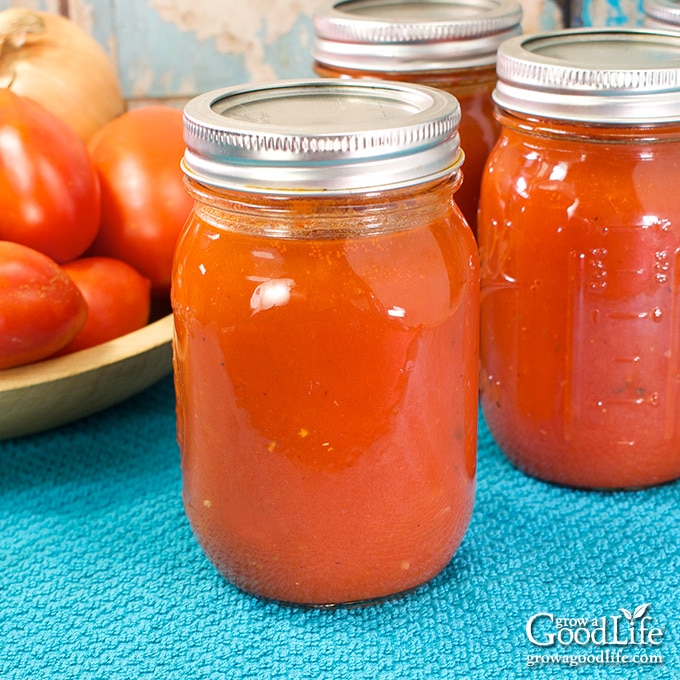
I talk about canning tomato sauce a lot here at Grow a Good Life, especially this year as I faced the challenge of preserving a bumper crop. It seems I constantly had baskets of ripe tomatoes to work through for the last two months. Now that the final tomato harvest is simmering on the stove, I thought it was time to share the tomato sauce recipe and method I use to preserve the majority of my homegrown tomato harvest.
Growing up in an Italian household, the only tomato sauce we were aware of was the homemade kind made from canned or fresh tomatoes in season. There were no jars of purchased tomato sauce in our pantry. As an adult, I continued the tradition cooking up large batches of homemade tomato sauce and freezing it for future meals.
When I began growing a garden of my own, one of the first things I learned to can was tomato sauce from homegrown tomatoes. Eventually, I made it my yearly goal to grow enough tomatoes to provide a sufficient amount of canned tomato sauce to last us until the following season.
No store bought tomato sauce compares with the flavor of homemade. This is the seasoned tomato sauce recipe and method I use to home can the tomato harvest.
Tips for Canning Tomato Sauce
Here are tips for turning freshly harvested tomatoes into homemade tomato sauce and canning it in shelf stable jars:
Follow a Safe Canning Recipe
If you are canning tomato sauce, is important to use recipes that are formulated and tested for safe home canning. When I make tomato sauce for canning, I follow the seasoned tomato sauce recipe in the Ball Blue Book Guide to Preserving. This is the closest to the homemade tomato sauce I grew up with.
Use Paste Tomatoes
Use plum type tomatoes for a flavorful and thick sauce. My favorites are Amish Paste, Juliet, Roma, and San Marzano. Plum tomatoes, also referred to as paste tomatoes, are meaty with thick walls and have very little water content. You can still use other types of tomatoes, but it may take longer for the extra water to cook out.
Choose good-quality tomatoes with no signs of rot, insect damage, or disease. Don’t use tomatoes from frost-killed vines as the acidity may have changed or these may harbor harmful pathogens that may not be killed during processing.
Remove Skins and Seeds
If you are canning tomatoes, you need to remove the seeds and peels in recipes that call for it. So far, there are no tested canning recipes that include the skins. The peels may harbor bacteria, and add unwanted texture to the sauce. Additionally, the peels and seeds may affect the density of the sauce, preventing heat from penetrating properly when processed in a water bath canner.
This recipe calls for simmering the tomato sauce with the skins and seeds first, and then straining out the solids from the tomato pulp. Cooking with the skins and seeds aids in extracting the natural pectin that will help thicken the sauce.
The way I do the initial cooking depends on the weather. If it is hot outside, I will simmer the sauce on the stove as described in the recipe. If the weather is cooler, I roast the vegetables first in a 325˚F oven until softened, about an hour. Then add all the ingredients to a pot and simmer until the sauce has thickened and reduced by half. Roasting adds a lovely, deep tomato flavor to the finished sauce. Be sure to include all the liquid that releases from the tomatoes.
After the sauce has reduced by one-half, strain with a food strainer or food mill to remove solids, and smooth out the sauce. Then return the sauce to the stove, heat to a simmer, and fill the jars.
If you don’t have a food strainer, you can blanch and peel the tomatoes, and scoop out the seeds before making your sauce: See How to Peel Tomatoes for an illustrated, step-by-step tutorial.
Acidifying Tomatoes
When canning tomatoes, an acid is needed to ensure that the pH is at a level that prevents the growth of C. Botulinum bacteria, which causes botulism. There are two simple ways you can use to adjust the acidity when canning tomatoes. Add citric acid or commercial bottled lemon juice:
- Citric acid is my favorite way to acidify tomatoes because it does not affect the flavor.
- Bottled Lemon Juice: Bottled lemon juice has been uniformly acidified so there is a consistent and known acid (pH) level that is needed for safe canning. Don’t use fresh squeezed lemon juice because there is no way to know the level of acid in the juice.
Don’t Have a Water Bath Canner?
You can use a standard large stockpot as long as it is tall enough to cover the jars by two inches of water, and at least two more inches of air space to prevent boiling water from splashing out. You will need to use a rack in the bottom of the pot to hold the jars up away from direct heat, so they won’t break, and can in smaller batches depending on how many jars your pot will hold.
Steps to Making and Canning Tomato Sauce
This home canned seasoned tomato sauce is perfect for tossing with spaghetti and pasta, spreading on homemade pizza, and spooned over chicken or eggplant Parmesan.
Before you begin, it may be helpful to review this article on water bath canning at the National Center for Home Food Preservation website.
This is a safe caning recipe from the Ball Blue Book Guide to Preserving for “Seasoned Tomato Sauce.” The differences between this recipe and the Ball seasoned tomato sauce is this recipe has been cut in half. I just find working with a smaller batch of tomatoes much easier to manage since I only have two large pots to cook down the sauce.
Seasonings have been adjusted slightly to reduce the amount of salt, and increase the sugar to balance the tart flavor of the tomato sauce. I also reduce the sauce by slow cooking it over low heat for a longer period to preserve flavor rather than cooking over medium-high heat as indicated in the Ball recipe. Sometimes this takes all day, but the flavor is worth the effort.
The full and printable recipe can be found at the bottom of this article, but these are the steps for making and canning Italian seasoned tomato sauce:
Step 1: Gather Your Equipment
You’ll need:
- Water bath canner with canning rack
- 8 pint sized canning jars, or 4 quart sized jars
- Canning lids and bands (new lids for each jar, bands can be reused)
- Canning tools: jar lifter, canning ladle, funnel, and bubble popper
- Kitchen scale
- Food strainer, food mill, or sieve
- Plus basic kitchen supplies such as a large saucepan, large prep bowls, towels, measuring cup, measuring spoons, large spoon, knife, and a cutting board.
Step 2: Prepare the Ingredients
Weigh and wash tomatoes well under clean, running water, and spread out to air dry on towels. Remove the peelings from the onions. Chop and measure 3 cups of chopped onions. Peel the garlic and mince.
Step 3: Cook the Sauce
Heat a large skillet over medium heat, add the olive oil, and sauté the onions until softened. Add the garlic and cook briefly until fragrant, then add the mixture to your saucepan.
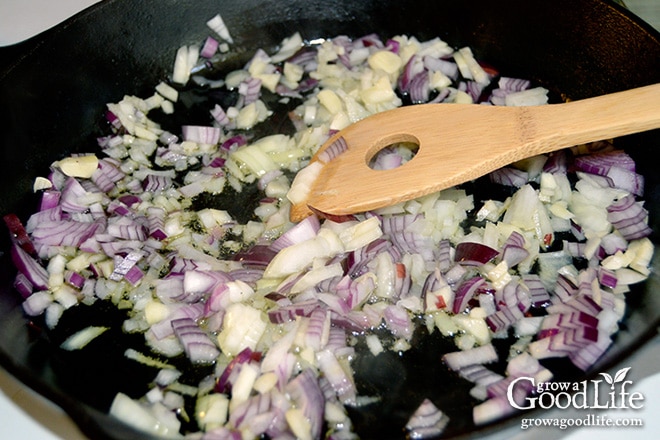
Cut the tomatoes in half or quarters and add to your pot along with the oregano, bay leaves, black pepper, sugar, and red pepper flakes if using. Hold off on the salt for now and add it to taste at the end.
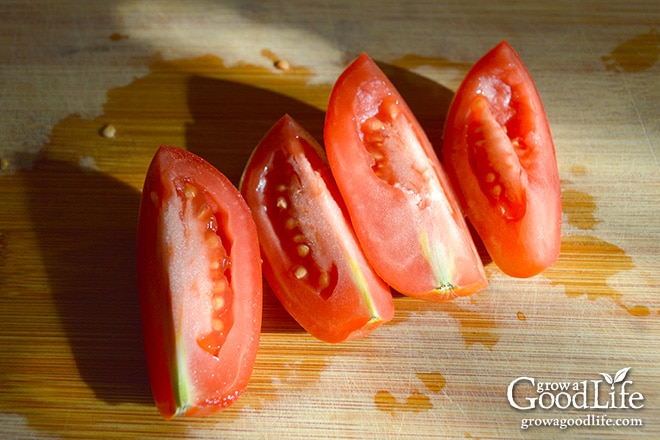
Cover and bring the pot to a simmer over low heat. Vent the cover to let the moisture evaporate, and continue simmering to thicken the sauce until reduced by one-half. The cooking time will vary depending on the amount of moisture in your tomatoes. Stir occasionally to prevent sticking.
If you are using multiple pots, roughly divide the ingredients for each pot, and combine into one pot as the sauce cooks down. Use your ladle to avoid splashing.
Once the volume is reduced by half, turn off the heat, and let it cool slightly so you won’t burn yourself when straining.
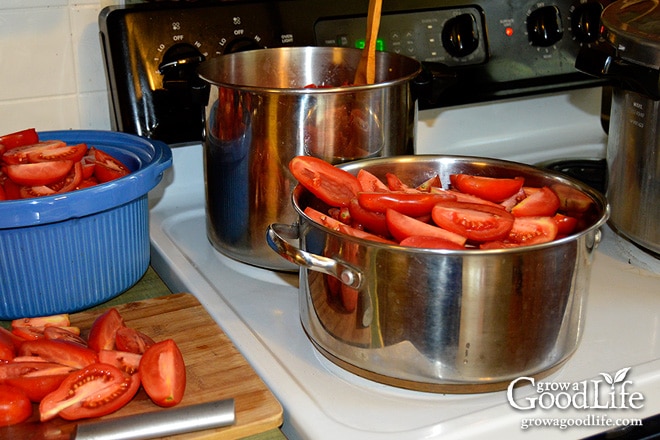
Step 4: Prepare the Canning Equipment
While the sauce is cooling, prepare the jars, set up the canner, and organize your work area.
Wash your jars, lids, bands, and canning tools in warm, soapy water. Rinse well, and set the lids, bands, and tools aside to air dry until you are ready to use them.
Jars must be heated before filling to prevent breakage due to thermal shock. Place the jar rack into the water bath canner, set the jars upright in the canner, and add water to cover the jars. Bring the canner to a simmer (180˚F) for 10 minutes, and keep the jars hot until you are ready to fill them.
Follow the manufacturer’s directions for preparing the lids. Pre-heating lids is no longer necessary before using, but it is still safe to simmer (180°F) the lids if you want to. Just add them to the canner when you heat your jars.
Step 5: Strain the Sauce
Remove the bay leaves, and run the tomato sauce through a food strainer or food mill to remove skins, seeds, and to smooth out the sauce. Return the sauce to the pot, and bring the sauce back to a simmer (180˚F). Use a clean spoon and taste the sauce. Add salt and stir in. Taste again. Add more salt if needed.
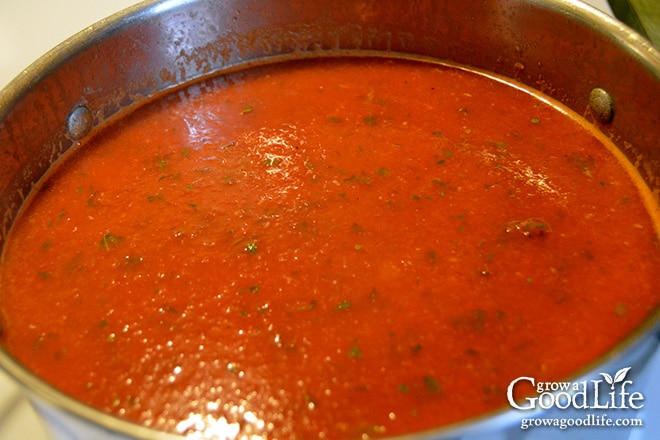
Step 6: Can the Sauce
Spread a kitchen towel on the counter, and place the citric acid or lemon juice nearby along with the measuring spoons.
Use the jar lifter to remove a hot jar from the canner, drain, and place on the towel. Keep the remaining jars in the canner, so they stay warm.
Add citric acid or lemon juice to the jar. For pints, add 1/4 teaspoon of citric acid, or 1 tablespoon of bottled lemon juice to each jar. For quarts, add 1/2 teaspoon citric acid or 2 tablespoons of bottled lemon juice to each jar.
Place the canning funnel on the jar, and ladle hot sauce into the jar while leaving 1/2-inch headspace. Run the bubble popper through the jar to release any trapped air bubbles.
Wipe the rim with a damp towel to remove residue. Center a lid on the jar, place the band over the lid, and screw it on until fingertip tight. Place the jar back into the canner, and repeat with the rest of the jars.
Adjust the water level so it is covering the jars by several inches, bring the pot to a boil, and process the jars for the times indicated in the recipe below. Let the jars cool, test the seals, label and date the jars, and store in a cool, dark location.
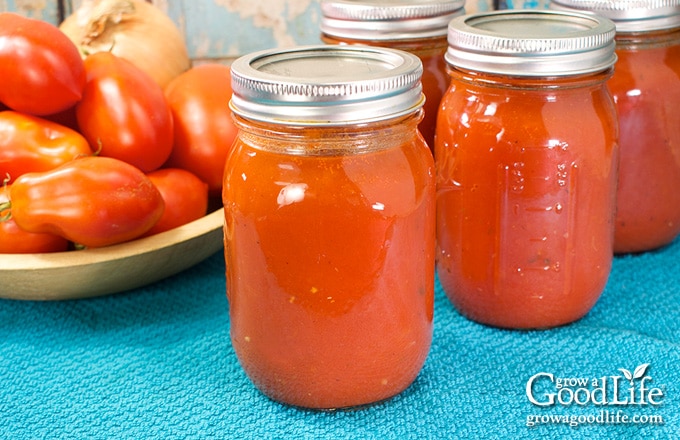
Seasoned Tomato Sauce Recipe
Ingredients
- 22.5 pounds paste tomatoes
- 3 cups chopped onions about 3 large onions
- 6 cloves garlic minced
- 1/4 cup extra virgin olive oil
- 3 dried bay leaves
- 1 tablespoon dried oregano
- 1 teaspoons cane sugar
- 1.5 teaspoon ground black pepper
- 1 teaspoons red pepper flakes optional
- citric acid or bottled lemon juice
- 1 teaspoon kosher salt or more to taste
Instructions
Prepare the Ingredients
- Weigh the tomatoes, rinse well under clean, running water, and air dry on a clean towel.
- Remove the peelings from the onions. Chop and measure 3 cups of chopped onions. Peel the garlic and mince.
Make the Sauce:
- Heat a large skillet over medium heat, add the olive oil, and sauté the onions until softened. Add the garlic and cook briefly until fragrant, then add the mixture to your saucepan.
- Cut the tomatoes in half or quarters and add to the pot along with the bay leaves, oregano, sugar, black pepper, and red pepper flakes if using.
- Bring the pot to a simmer over low heat, and continue simmering to thicken the sauce until reduced by one-half. Stir occasionally to prevent sticking.
- Once the volume is reduced by half, turn off the heat, and let the sauce cool slightly before straining.
Prepare the Canning Equipment:
- Wash your jars, lids, screw bands, and canning tools in hot soapy water. Rinse thoroughly to remove all suds. Set aside to air dry on a clean kitchen towel.
- Place the jar rack into water bath canner, place jars in the canner, and add water to cover. Bring the canner to a simmer (180˚F) for 10 minutes, and keep the jars hot until you are ready to fill them.
Can the Sauce:
- Remove the bay leaves, and purée the tomato sauce using a food strainer or food mill to remove skins, seeds, and to smooth out the sauce. Return the strained tomato sauce to the saucepot, and bring back to a simmer (180˚F).
- Use a clean spoon and taste the sauce. Add salt and stir in. Taste again. Add more salt if needed.
- Spread a kitchen towel on the counter. Place the citric acid or lemon juice along with the measuring spoons next to the towel.
- Use your jar lifter to remove a jar from the canner, drain, and place on the towel. Keep the remaining jars in the canner so they stay hot.
- Add citric acid or lemon juice to the jar. For pints, add 1/4 teaspoon of citric acid, or 1 tablespoon of bottled lemon juice to each jar. For quarts, add 1/2 teaspoon citric acid or 2 tablespoons of bottled lemon juice to each jar.
- Use your canning ladle and funnel and add the hot sauce to the warm jar leaving 1/2-inch headspace. Swirl your bubble popper through the jars to release air bubbles. Wipe the rim of each jar with a damp towel.
- Center a lid on the jar, and screw on the band until it is fingertip tight. Use the jar lifter to place the jar back into the canner, and repeat with the remaining jars. Try to leave some space in between the jars.
- Once all the jars are in canner, adjust the water level to two inches above the jar tops.
- Cover the canner and bring to boil over high heat. Once water boils vigorously, set your timer, and process pints for 35 minutes and quarts for 40 minutes at altitudes of less than 1,000 ft. Adjust processing time for your altitude if necessary (see notes).
- When processing time is complete, turn off the heat and allow the canner to cool down and settle for about 5 minutes.
- Spread a kitchen towel on the counter, and remove the cover by tilting lid away from you so that steam does not burn your face.
- Use the jar lifter to lift jars carefully from canner and place on the towel. Keep the jars upright, and don't tighten bands or check the seals yet. Let the jars sit undisturbed for 12 to 24-hours to cool.
- After the jars have cooled for at least 12 hours, check to be sure jar lids have sealed by pushing on the center of the lid. The lid should not pop up. If the lid flexes up and down, it did not seal. Refrigerate the jar and use within a few days.
- Remove the screw on bands and wash the jars. Label, date, and store your jars in a cool, dark place. Use within 12 to 18 months. Refrigerate the sauce once opened and consume within a few days. Yields about 6-7 pint jars or 3-4 quarts depending on how much the sauce reduces.
Notes
- Pints at altitudes of 1,001 - 3,000 ft. is 40 minutes, 3,001 - 6,000 ft. is 45 minutes, and above 6,000 feet is 50 minutes.
- Quarts at altitudes of 1,001 - 3,000 ft. is 45 minutes, 3,001 - 6,000 ft. is 50 minutes, and above 6,000 feet is 55 minutes.
Nutrition
This article was originally published on October 8, 2015. It has been reviewed and updated with additional information and new photos.
Additional Canning Information:
- USDA Complete Guide to Home Canning
- Canning Guides at the Ball Website
- 6 Tips to Prepare for Canning Season
You May Also Like:
Good planning is key to a successful vegetable garden
Whether you are new to growing your own food or have been growing a vegetable garden for years, you will benefit from some planning each year. You will find everything you need to organize and plan your vegetable garden in my PDF eBook, Grow a Good Life Guide to Planning Your Vegetable Garden.

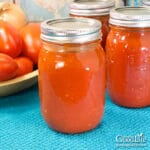

How long does it take to thicken, i cooked and cooked and its not thickening.
Melissa, Simmer until the volume is reduced by half. The thickness will vary depending on the types of tomatoes you used.
I love your recipes! I have always made the tomatoes by originally starting them out in a pot, but I do want to try oven roasting them too. Should I cut them, and would they be better open side up or down? Or does it not matter at all? I have a mixture of different kinds of really meaty tomatoes. Thanks!
Rosemarie, I would cut the larger tomatoes into similar size pieces so they cook evenly, but doesn’t matter how you place the tomatoes on the baking pan. Just be sure your pan has edges because the tomatoes will soften, crack, and release their juices as they roast.
Can I use yellow tomatoes
Ben, Yes, yellow tomatoes can be used the same way as red in this recipe. I hope you enjoy it!
What’s the pressure to be on this with elevation over 1000
Lisa, First, I just want to be sure you understand that this is a water bath canning recipe, not a pressure canning recipe. The adjustments for altitude when processing in a water bath canner are:
-Processing time for pints at altitudes of 1,001 – 3,000 ft. is 40 minutes, 3,001 – 6,000 ft. is 45 minutes, and above 6,000 feet is 50 minutes.
-Processing time for quarts at altitudes of 1,001 – 3,000 ft. is 45 minutes, 3,001 – 6,000 ft. is 50 minutes, and above 6,000 feet is 55 minutes.
Curious, I always thought when processing tomatoes only glass pots were to be used. There is no mention of that in your recipe…. Can stainless pots really be used? Thanks!
Kathy, Yes, stainless steel pots can be used to cook tomatoes. Stainless steel is a nonreactive metal and will not affect the flavor of the tomato sauce. Do avoid using aluminum, cast iron, and copper pots because these may alter color and flavor.
Hi. Thanks for the recipe! I made it last night and used a food mill, but I can see an errant seed or two in the sauce now that it’s in the jars. Is that ok? I mean I used another Ball recipe to can tomato chunks and there’s lots of seeds in those jars (per the recipe I wasn’t supposed to deseed the tomatoes, just peel them) so I’m surprised to hear seeds are such a huge problem. On the other hand I don’t want to die of botulism , so there’s that too. Thanks!
Christine, As long as you followed the recipe for Seasoned Tomato Sauce, finding a few seeds in your jar is ok. This recipe has not been tested with seeds, therefore we have no way of knowing if including the seeds has any affect on the safely of the sauce. That’s why we remove them.
As far as the Ball recipe you used for canning crushed tomatoes, that one doesn’t require removing the seeds. That is ok for that particular recipe because it was tested and deemed safe by Ball with the seeds. Does that make sense?
Can I use a blender after it is cooked instead of a food mill? We don’t mind the seeds and peelings. When I make pasta sauce and freeze it, we leave the seeds in the sauce. I just roast the tomatoes in the oven then use the blender to make it thick. We are new to canning, and I didn’t know if that was safe. Also can you add dried basil? Thank you so much for sharing!
Ara, Removing the skins and seeds is required for this recipe. Actually, there are no tested tomato sauce canning recipes from reliable sources that include the tomato skins. There is no way to know if the skins and seeds will interfere with the pH or how the heat penetrates the tomato sauce when the jars are processed. You can freeze your sauce instead if you wish to leave the skins, seeds, or make changes to the recipe.
I made this recipe, and it came out well and tasted very good.. am wondering if I could just run the washed tomatoes through a foodmill first and thereby saving the wait time while cooked tomatoes cool down?
Wayne, Yes, you can run the tomatoes through a strainer first. The reason I cook them first is to preserve the natural pectin that will help thicken the sauce.
If you crush raw tomatoes, it triggers an enzyme called Pectose (Pectinesterarse), which immediately begins to break down the pectin in the fruit and turn it into a liquid. It is the same thing that occurs when you chop a tomato, place it in a bowl, and discover a pool of liquid that wasn’t there before. That is the enzyme at work breaking down the pectin that holds the tomato’s cells together.
Heating the tomatoes first destroys the enzyme, preserving the pectin that will help thicken the sauce, and prevent it from turning into extra liquid that you will take longer to cook down.
Would you happen to know the measurement in volume (cups/quarts,etc) that the 22 lbs of tomatoes comes to before you put them through the food mill? I have some paste tomatoes that I have peeled & diced & not sure if the weight would be the same if they were whole.
Natalie, Sorry, I do not. Measuring by volume is not accurate here because it can fluctuate depending on the size of your pieces and how tightly they are packed. You will need to go by weight for this recipe.
I only have 11 pounds of tomatoes. Can I half the recipe but use the correct amount of citric acid for each size jar I use?
Betty, Yes, you can cut the recipe in half. The amount of citric acid will stay the same per jar: 1/4 teaspoon for pints, and 1/2 teaspoon for quarts.